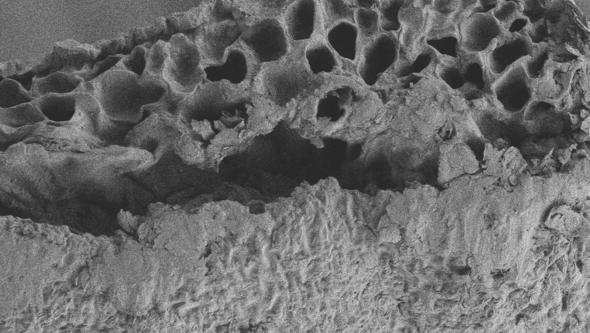Climate change is increasing carbon dioxide levels in the sea, causing bladderwrack seaweed to grow more quickly and to increase in size along the coast. However, a scientific study by researchers from the University of Gothenburg shows that this growth is illusory as, in more acidic seas, the seaweed will be unable to withstand storms and powerful waves.
Ocean acidification is a consequence of the oceans absorbing a large proportion of the carbon dioxide that is being released into the atmosphere. The drop in pH changes the conditions for the plants and animals that live in our seas. The ocean has already become more acidic and the worst-case scenario from the IPCC predicts an even further drop in pH, from 8.1 today down to around 7.7 by the end of this century.
"That might not sound very much, but pH is a logarithmic scale so it's a big difference. We are already seeing calcifying species such as shellfish finding it more difficult to survive today," says Alexandra Kinnby, a marine biologist at the University of Gothenburg.
Bladderwrack more fragile
Alexandra Kinnby has been studying bladderwrack for several years to see how the seaweed responds to climate change. Her studies show that even though bladderwrack is not a calcifying species, it has been affected by the increase in ocean acidity. It is true that bladderwrack is growing more quickly than before but it is also becoming more fragile. Ultimately, this may mean a risk that the fields of bladderwrack along the coast, which form key habitats, will be swept away in powerful storms.
"When I grew bladderwrack in water with a pH of 7.7, photosynthesis was stimulated due to the higher carbon dioxide content. Growth increased by 34 percent compared to growth in the oceans today. This could be a positive outcome. Bladderwrack creates important habitats for snails that eat the algae and crabs which in turn eat the snails. The increase in photosynthesis captures more carbon dioxide, making the ocean a carbon sink," says Alexandra Kinnby. However, she goes on to reveal the major downside of ocean acidification for the seaweed species.

Structure more porous
"Bladderwrack uses calcium and magnesium in the ocean to form the structural compounds that make up its cell walls. But at a lower pH, it appears to not bind these elements as well as it normally would. This makes the plant structure much weaker. In tests, half as much force was needed to pull the bladderwrack apart at a pH of 7.7 compared with today."
In the study, published in the scientific journal Current Biology, Alexandra Kinnby and her colleagues from the University of Gothenburg and KTH, the Royal Institute of Technology also saw major differences in bladderwrack structure under a microscope. When it is grown in more acidic seawater, the seaweed gains large cavities and its structure is more porous. The seaweed grown in normal seawater is more compact and so tougher when exposed to coastal waves and storms.
Rapid acidification of the oceans
Climate researchers judge that extreme weather events, such as powerful storms, will become more frequent as a consequence of climate change. This brings a risk that more bladderwrack will be detached from the seabed and die, so threatening important coastal habitats.
"Ocean acidification is happening more quickly than it ever has before. To my knowledge, our study is the first to study the impact of acidification on the strength of a non-calcifying marine algae species. I will be conducting more research to see if the effects on bladderwrack also apply to other macroalgae," says Alexandra Kinnby.
Scientific article in Current Biology: Ocean acidification reduces tissue strength in a non-calcifying foundation seaweed






